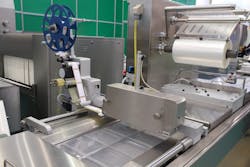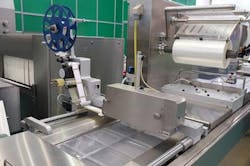Each and every day, thousands of consumer products are packaged across the United States from fresh and processed food to electronics, medications, office supplies, toys, and many more. Sophisticated, automated machinery drives these processes, which usually end with the precise cut of a formed blade.
Here are five of the most common uses of formed blades in factory production processes.
1. Tray Sealing
Tray sealing machines apply a plastic film lid to trays of various sizes, thicknesses, and materials. Most often used to package meat, fruit, vegetables, and other food items, a tray sealing machine creates a hermetic seal that protects food from contamination, improving food safety.
Some tray-sealing machines can modify the atmosphere inside the packaging, extracting excess oxygen to increase product shelf life. Others utilize specialty films to reduce product contamination from UV radiation or harmful gases.
Tray sealing is one of the most cost-effective and environmentally friendly food packaging solutions since products can be packaged using up to 25% less material than other packaging methods.
To work at optimal performance, tray sealing machines feature sealing blades that cut the plastic film covers, effectively separating each individual product for boxing and shipping. Sharpness and cutting accuracy are particularly important when considering replacement blades.
2. Blister Packaging
Blister packaging is a common form of packaging created by enclosing a product in a clear, pre-formed plastic bubble that is heat-sealed to a cardboard backing. Used for thousands of consumer products from toys and hardware to electronics and office supplies, blister packaging provides product security, while allowing the contents to be easily viewed by the consumer.
Blister packaging is also a popular form of packaging for pharmaceuticals and over-the-counter medications. Individual tablets, lozenges, or capsules are placed inside unit dosing packages. Some blister packs feature a push-through pack (PTP) backing that allows each dose of medication to be pressed out of the blister pack with a press of a thumb.
The most significant advantage of blister packaging is tamper resistance. Obvious visual cues can either alert consumers to tampering or reassure them that a product has not been compromised.
Manufacturing machinery used to create blister packaging varies based on the specific application. Custom blades are often required to cut each product for boxing and shipping or to score or slit packaging for easy opening by the end consumer.
3. Pouching
Stand-up pouches have become a popular packaging option for many food products including individual servings of fruits, yogurt, and even some pet foods and treats. Popular for both dry and liquid products, pouches are very durable, user-friendly, and can easily feature brand logos and attractive color options.
Pouches are created using a continuous web of blended plastic film and aluminum foil. The first step in the process passes the material through a set of plows that fold the material into a W-shaped gusset to form the bottom of the pouch.
Zippers can also be added to the packaging to make the resulting product re-sealable. If a zipper is called for, the next stage involves sealing the inside edges of the material near the top edge. If zippers are not used, spouts, perforations or other re-closeable options are available.
The next step in the process seals the pouch's sides. A zipper or other re-closeable option is added to the top of the pouch to seal it completely. Finally, the bottom folds of the pouch are sealed. The pouch is cut apart through the center of the side seals in preparation for filling.
At this point, individual pouches are filled at another station in the manufacturing facility and then resealed.
Forming blades are integral to the process of creating pouches. Some machines require custom blades to seal, add zippers, spouts, or perforations during the manufacturing process.
4. Cup Sealing
Another important application for formed blades is cup-sealing machinery. Cup sealers enable food manufacturers to add product to a pre-portioned cup, and then seal the top with various types of seals from plastic to aluminum foil. This packaging preserves the freshness of the product, while also providing added safety through tamper-evident packaging. Convenience foods such as soups, yogurt, gelato, ice cream, sauces, and snacks often use cup sealing. Cup sealing is also used in beverages and in some medical packaging applications.
5. Notching
The process of notching uses formed blades to create handles in many types of plastic shopping bags. Different blades are used to create a variety of handle types from simple loops to rectangular notches. Sharp, accurate blades are required to ensure precise cuts for consistency and usability.
While each of the applications above utilizes different methods to produce finished products, one of the most important elements of the packaging process is accurate and durable forming blades that keep the production process moving smoothly.
Regardless of the specific production process you use, Leverwood Knifeworks can help you select the right tray sealing or forming blade for your application. From material selection to edge configuration, we guarantee consistency and durability throughout your manufacturing process.
Based in South Central Pennsylvania, Leverwood Knifeworks manufactures blades for both domestic and foreign equipment, utilizing a highly skilled team of precision toolmakers. Contact us today to find out how we can help your operation stay sharp!
This article was originally posted on Leverwood Knife Works' website which can be viewed here: https://www.leverwood.com/5-common-applications-for-formed-blades/






